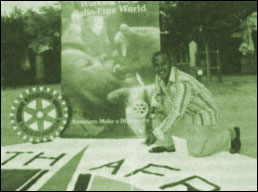

34,700 Rotarians from 528 districts raised nearly US$111.5 million for the polio eradication fundraising campaign.
"I thought the purple pinkie would be a powerful and personal symbol of one child saved from polio." -John Wheeler
Inspiration often visits when you least expect it. For Rotarian John Wheeler, it arrived last March in the form of a photograph, published in The Rotarian, of six young Ethiopian boys displaying their tinted pinkie fingers with curiosity and resolve.
An article in the special section, "March on Polio," explained that after a child receives a dose of oral polio vaccine during a National Immunization Day, or NID, a finger or thumb is dabbed with colored dye to indicate the youngster has been immunized.
 Wheeler, a member of the Rotary Club of Lake City, Fla., USA, recalled how America children love to have their faces and hands painted at street fairs and block parties. Two months later, he and his club launched the Purple Pinkie Project to raise money for the polio eradication fundraising campaign (PEFC).
Wheeler, a member of the Rotary Club of Lake City, Fla., USA, recalled how America children love to have their faces and hands painted at street fairs and block parties. Two months later, he and his club launched the Purple Pinkie Project to raise money for the polio eradication fundraising campaign (PEFC).
For a donation of $0.60 - the cost of vaccine needed to immunize one child against polio - students from all schools in Columbia County, Fla., could have a finger painted with gentian-violet ink, a biological stain used in fingerprinting and throughout Africa during NIDs.
"I thought the purple pinkie would be a powerful and personal symbol of one child saved from polio,' Wheeler says.
He was right. The project attracted about 1,200 children and teens, many who donated $6 to have all 10 fingers painted. With matching funds from Carl Allison, a Lake City Rotarian, the project $4,060 for the PEFC.
Wheeler's initiative is just one example of the creativity that Rotarians exhibited worldwide to boost the PEFC past its goal of US$80 million in cash contributions, District Designated Fund allocations, pledges, and government matching funds. Rotary leaders announced during this June's RI Convention, in Brisbane, Australia, that the campaign total had reached $88.5 million. The active campaign ended on 30 June; but the pledges are payable until 30 June 2005, and Rotarians are urged to continue sending donations. By the end of the campaign, the total figure had reached nearly $111.5 million, says Herbert Pigman, former RI general secretary and the PEFC's original director.
Robert Scott, chair of the Polio Eradication Advocacy Task Force, who took over as PEFC director in October 2002, calls Rotarians' response to the fundraising challenge "absolutely amazing." He says all but one of Rotary's 529 districts contributed. More than 120 countries participated, and more than 34,700 Rotarians actively campaigned to raise funds. "I can't believe that any other organization, religious or otherwise, could get such an international [response] in such a short time."
![]() Read more by subscribing!
Read more by subscribing!
![]() Discuss this article here
Discuss this article here